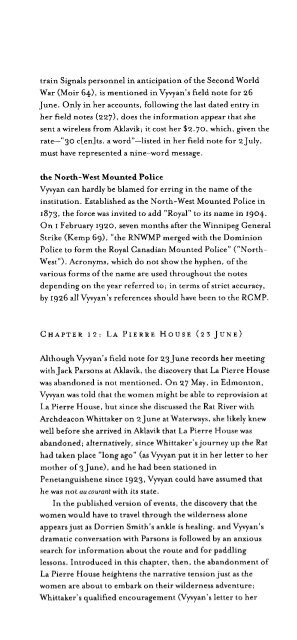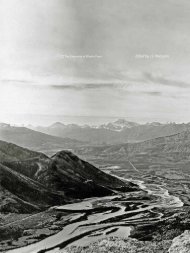C Ihe Ladies c cu. V'VVAN - History and Classics, Department of
C Ihe Ladies c cu. V'VVAN - History and Classics, Department of
C Ihe Ladies c cu. V'VVAN - History and Classics, Department of
- No tags were found...
Create successful ePaper yourself
Turn your PDF publications into a flip-book with our unique Google optimized e-Paper software.
Notes to Pages 67-73 265train Signals personnel in anticipation <strong>of</strong> the Second WorldWar (Moir 64), is mentioned in Vyvyan's field note for 26June. Only in her accounts, following the last dated entry inher field notes (227), does the information appear that shesent a wireless from Aklavik; it cost her $2.70, which, given therate-"30 c[enlts. a word"-listed in her field note for 2]uly,must have represented a nine-word message.the North-West Mounted PoliceVyvyan can hardly be blamed for erring in the name <strong>of</strong> theinstitution. Established as the North-West Mounted Police in1873, the force was invited to add "Royal" to its name in 1904.On I February 1920, seven months after the Winnipeg GeneralStrike (Kemp 69), "the RNWMP lllerged with the DominionPolice to form the Royal Canadian Mounted Police" ("NorthWest"). Acronyms, which do not show the hyphen, <strong>of</strong> thevarious forms <strong>of</strong> the name are used throughout the notesdepending on the year referred to; in terms <strong>of</strong> strict ac<strong>cu</strong>racy,by 1926 all Vyvyan's references should have been to the RCMP.CHAPTER 12: LA PIERRE HOUSE (23 ]UNE)Although Vyvyan's field note for 23]une records her meetingwith]ack Parsons at Aklavik, the discovery that La Pierre Housewas ab<strong>and</strong>oned is not mentioned. On 27 May, in Edmonton,Vyvyan was told that the women might be able to reprovision atLa Pierre House, but since she dis<strong>cu</strong>ssed the Rat River withArchdeacon Whittaker on 2]une at Waterways, she likely knewwell before she arrived in Aklavik that La Pierre House wasab<strong>and</strong>oned; alternatively, since Whittaker's journey up the Rathad taken place "long ago" (as Vyvyan put it in her letter to hermother <strong>of</strong> 3 ]une), <strong>and</strong> he had been stationed inPenetanguishene since 1923, Vyvyan could have assumed thathe was not au courant with its state.In the published version <strong>of</strong> events, the discovery that thewomen would have to travel through the wilderness aloneappears just as Dorrien Smith's ankle is healing, <strong>and</strong> Vyvyan'sdramatic conversation with Parsons is followed by an anxioussearch for inforlllation about the route <strong>and</strong> for paddlinglessons. Introduced in this chapter, then, the ab<strong>and</strong>onment <strong>of</strong>La Pierre House heightens the narrative tension just as theWOlllen are about to elllbark on their wilderness adventure;Whittaker's qualified encouragement (Vyvyan's letter to hermother <strong>of</strong> 3]une finds him "rather gloomy about our trip")<strong>and</strong> Sgt Anderton's confident encouragement are balanced byVyvyan's own retrospective evaluation <strong>of</strong> the wOlllen' sresources. The tension might be regarded as one between twoidentities, "mere tourists" (41) <strong>and</strong> "seasoned travellers" (73).Will the sprained ankle permit them to make themselves overinto travellers now that they are on the brink <strong>of</strong> the wilderness?The interview with Anderton permits Vyvyan to move from"dream" to "sober fact," a progression they must make if theyare to get up the Rat <strong>and</strong> over the Divide to the enchantment <strong>of</strong>three days alone on the Por<strong>cu</strong>pine River.Apart from the interview with Anderton, the contents <strong>of</strong>the chapter have no equal in the field notes.the ntanager <strong>of</strong> the Hudson's Bay Contpany store, MrParsons]ohnAmbrose Parsons (1886-1974) was born in Codroy,Newfoundl<strong>and</strong>, <strong>and</strong> served as a constable <strong>of</strong> the RNWMP from1909 to 1916, taking his discharge after serving in Yorkton,Kamsack, Punnichy, Athabasca L<strong>and</strong>ing, Fort McPherson, <strong>and</strong>Herschel Isl<strong>and</strong> (Zealley to MacLaren). The following year hejoined the HBC, <strong>and</strong> throughout his career (1917-31) heworked as a post manager in the western Arctic. He was atBaillie Isl<strong>and</strong> 1917-20, at Fort McPherson 1920-24, <strong>and</strong> atAklavik 1924-30, before returning to Fort McPherson for hisfinal year in the company's service. He then became an independenttrader at Aklavik ("Parsons"). In the winter <strong>of</strong> 1932,he was involved in the hunt for Albert] ohnson, the "MadTrapper" (Zealley to MacLaren).a trader <strong>and</strong> also a trapperIt is possible that Vyvyan here preserves a distinction in the twoterms as sometimes used in the North: "trader" refers to whitetrappers <strong>and</strong> "trapper" to non-whites.our friend Sergeant AndertonSgt Frederick Anderton (1889-1974) was born inLeicestershire, Engl<strong>and</strong>, <strong>and</strong> served with the LeicestershireConstabulary 1910-12 before emigrating to Canada. He joinedthe RNWMP in 1913 at Regina, served in France <strong>and</strong> Belgiumduring the First World War, <strong>and</strong> returned to the force afterdemobilization. Promoted to sergeant in 1920 <strong>and</strong> sergeantmajor in 1934, he served throughout the northwest <strong>and</strong> theArctic from Regina <strong>and</strong> Edmonton to Herschel Isl<strong>and</strong> <strong>and</strong>
















